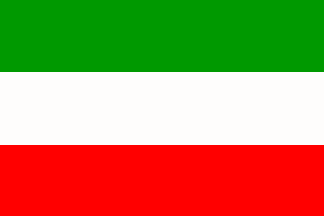
image by Daniel Rentería, 23 July 2024

Last modified: 2024-07-27 by daniel rentería
Keywords: azuay | gualaceo | san juan |
Links: FOTW homepage |
search |
disclaimer and copyright |
write us |
mirrors

image by Daniel Rentería, 23 July 2024
See also:
According to https://gadparroquialsanjuan.gob.ec/azuay/simbolos-parroquiales/:
"The flag of the parish is formed by three stripes of three striking colors, colors that belong to the range of cold and hot colors.
In the three colors, the real and proper identity of the parish is hidden.
Green - Symbolizes peace, serenity, and tranquility to all of the people that visit the parish in festive times or on the weekends; this color
symbolizes the serenity of its lovely and hospitable people. Furthermore, the color green is the living representation of its majestic vegetation
which San Juanenses enjoy, starting from the massive Pizhi Hill, through the Tari Mountain Range, the Cascade of Tasqui, and ending in the edges
of the Santa Barbara River.
White - Signifies the deep faith found in the people toward the Catholic religion, being faithful devotees of their patron, the Lord of Miracles.
On the other hand, white is linked to purity; this state we can appreciate in the hot and crystalline waters which run through the streams of the
Pizhi Hill — pure water which serves for the daily consumption of the parish — and ends in the edges of the majestic Santa Barbara River.
Red - Symbolizes the history of the San Juan traditions, representing the blood that previous generations spilled to not submit to Spanish rule,
as well as that of the game of the Pucaras, a game that consisted of meeting between neighboring parishes or communities to carry out a true fight,
in order to have prosperity in his parish. Finally, red reflects the positive clothing that inhabitants of the parish wear; these inhabitants show
red ponchos and red skirts, highlighting the glamor and beauty of the man and woman of San Juan."
Daniel Rentería, 23 July 2024
.gif)
from GAD San Juan, located 23 July 2024
"The parish, as indicated, was created in 1574. The coat of arms includes each of the historical events and iconic
places of the town of San Juan del Cid. Starting with its majestic Pizhi Hill, considered the parish's greatest tourist attraction, here we can find
lush vegetation with a great diversity of flora and fauna typical of this location.
Another essential element is the parish church, this is a construction that emerged with the colonization of the Spanish, the church has a unique composition
because it is based on the Gothic style but maintains essential features of the first homes of our ancestors. Within this construction we can find religious
images that are part of the parish's cultural heritage. Next to the church we can see another essential element, which is the sun, a star that the inhabitants
of the parish still pay tribute to today by its presence in the crops. This celebration can be observed in the month of October, the month of sowing, and in June,
the month of Inti Raymi.
Then we go to the banks of the Santa Bárbara River, this is a symbol of the barrier that the Spaniards could not cross when they tried to enter the parish;
this is because at the other end of the river our ancestors were fighting and attacking so as not to be subjugated by them. In the middle of the river we can see
a hand holding a hammer; this element represents work, strength, power and the tenacity of our natives. You can also see a large part of the vegetation within the shield.
At the edge of the shield, we can see that it has two laurel branches, which signifies independence, struggle, and the perseverance of the Sanjuanense people. And finally,
you can see a lit torch for the hope and progress of the inhabitants in the town that saw it start."
Daniel Rentería, 23 July 2024